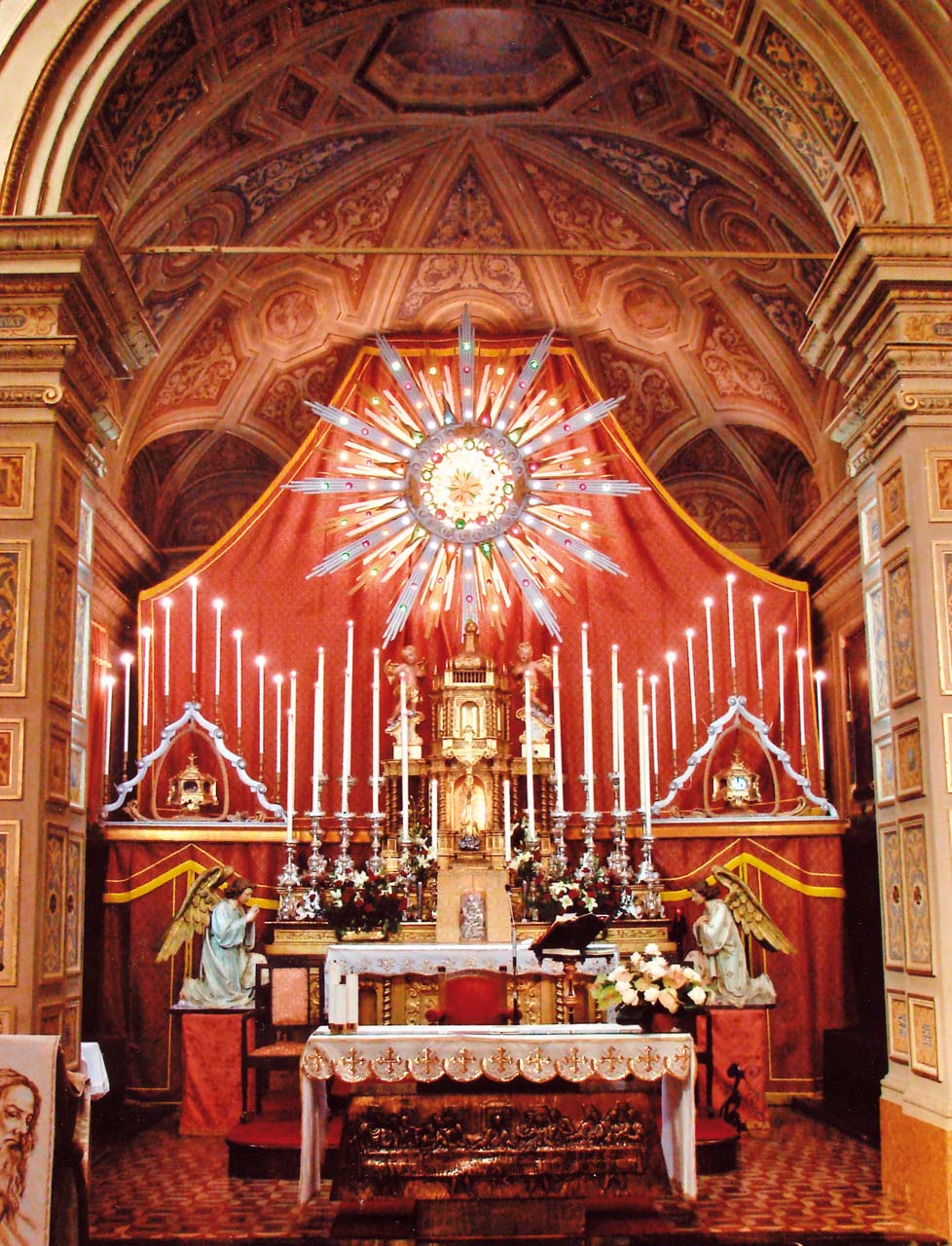Come accade per molte chiese, anche l’attuale parrocchiale di Barzizza fu oggetto di continue trasformazioni. La costruzione originaria, di cui si fa cenno in un atto del 1290, era di piccole dimensioni, non era parrocchiale poiché tale titolo spettava alla chiesa di S. Lorenzo; tuttavia la cappella dedicata a S. Nicola di Bari dal vescovo Polidoro Foscari l’8 agosto 1446 era normalmente utilizzata per le celebrazioni liturgiche e per amministrare i sacramenti, e ciò per comodità degli abitanti di Barzizza, diversamente costretti a recarsi nella chiesa di S. Lorenzo arroccata su uno sperone e lontana dal nucleo abitato. Nel 1535 il vescovo di Bergamo Pietro Lippomano fornisce una descrizione essenziale del luogo sacro caratterizzato da una navata decorata a fresco con due altari oltre all’altare maggiore completo della pala.

L’edificio sacro, a partire dal 1580, fu oggetto di profonde trasformazioni conclusesi nel 1614, anno in cui fu consacrato dal vescovo Giovanni Emo il 19 luglio, in concomitanza con la consacrazione della chiesa di S. Lorenzo. Alla fine del secolo XVII venne ricostruita l’abside e la torre campanaria, pericolante.
L’impianto attuale è del 1880 quando, su progetto del leffese Pietro Gallizioni, furono sopraelevate di 5 metri le pareti laterali realizzando il soffitto a botte. Anche il presbiterio venne nuovamente modificato e si provvide a realizzare una nuova pavimentazione. L’aspetto più innovativo fu quello dell’ampliamento dell’aula dei fedeli, accorpando il porticato; quest’ultimo intervento comportò il nuovo orientamento Nord-Sud.
La planimetria della chiesa propone un’aula ad unica navata con lesene a parete e con nervature ribassate del soffitto che articolano le superfici. La volta è disegnata da geometrie a stucco con dipinti di Ponziano Loverini (1882). Sull’arco trionfale che dà accesso al presbiterio, anch’esso ornato con riquadri a stucco ad andamento radiale, è rappresentato il Cristo in croce. Il presbiterio a pianta quadrangolare ha il soffitto a spicchi.
La facciata principale è disegnata da un’alta zoccolatura di pietra calcarea che fa da basamento delle lesene che inquadrano la fronte. Una breve scalinata raccorda le quote della piazza con l’interno, al quale si accede varcando un portale di arenaria sovrastato da uno stemma. Sotto il timpano che conclude la facciata una finestra termale illumina lo spazio sacro.
Nuovi interventi sono stati condotti all’inizio del Novecento e il 29 aprile 1939 il vescovo di Bergamo Adriano Bernareggi consacrava la chiesa.
La vita religiosa della Comunità ruota attorno alle festività che scandiscono l’anno liturgico. Molto sentite sono anche la festa del Patrono S. Nicola da Tolentino e il Triduo dei defunti, pia pratica nata per opera dei Francescani Osservanti. Il Triduo, quasi sempre celebrato nel periodo prossimo al carnevale coincide a volte, come nel caso di Barzizza, con il mese di novembre.
L’apparato barocco che interpreta la dottrina della Chiesa di quel particolare momento storico (tema del Purgatorio) è costituito dal grande telo (postergale) sul quale si staglia la raggiera il cui fulcro, dalla intensa luminosità, richiama il paradiso; qui viene collocato l’ostensorio con l’ostia consacrata. Le numerose candele che fanno da coronamento simboleggiano le anime purganti che anelano a Dio. Nell’aula sacra vibrante di luce la Comunità dei viventi intercede e consegna a Cristo le anime di coloro che non possono ancora godere della pienezza di Dio.
In Valle Gandino il Triduo dei defunti propone questo calendario:
Cazzano S. Andrea: due domeniche prima del carnevale
Leffe: una settimana prima del carnevale
Peia: prima settimana di Quaresima
Gandino: seconda settimana di Quaresima
Cirano: terza settimana di Quaresima
Casnigo: quarta settimana di Quaresima
Barzizza: seconda settimana di novembre
CHURCH OF St. NICHOLAS OF BARI
The current parish church of Barzizza endured continuous transformations as many other churches. The original building, which is mentioned in a deed from 1290, was small and was not a parish church since this title belonged to the church of St.Lawrence; however the chapel dedicated to St. Nicholas of Bari by bishop Polidoro Foscari on the 8 August 1446, was normally used for liturgical celebrations and to administer the sacraments, as this was easier for the inhabitants of Barzizza, who were otherwise forced to go to the church of St. Lawrence placed on a spur and far from the inhabited area. In 1535 the bishop of Bergamo Pietro Lippomano gave an essential description of the sacred place which was characterized by a nave decorated in fresco with two altars in addition to the main altar and its altarpiece.
Starting from 1580, the sacred building experienced big transformations which ended in 1614, that same year it was consecrated by Bishop Giovanni Emo on 19 July, the same day of the consecration of the church of St. Lawrence. At the end of the 17th century the apse and the unsafe bell tower were rebuilt.
The current structure dates back to 1880 when, based on a design by Pietro Gallizioni from Leffe, the side walls were raised by 5 meters creating the barrel-vaulted ceiling. The presbytery was also modified again and new flooring was created. The most innovative aspect was the expansion of the assembly hall of devotees, incorporating the portico; with this last intervention the new orientation was North-South.
The plan of the church consists of a hall with a single nave with half pilasters on the wall and with suspended ceiling ribs that give different form to the surfaces. The vault is designed with stucco geometries with paintings by Ponziano Loverini (1882). The triumphal arch when you enter the presbytery is also decorated with radial stucco panels and Christ on the cross is represented. The quadrangular presbytery has a segmented ceiling.
The main facade is designed by a high limestone plinth which acts as a base for the pilasters that frame the front. A short staircase connects the square with the inside, which you reach crossing a sandstone portal with a coat of arms. A Diocletian window that lights up the sacred space is placed under the tympanum.
New restoration works were carried out at the beginning of the twentieth century and on 29 April 1939 the bishop of Bergamo Adriano Bernareggi sanctified the church.
The religious life of the Community revolves around the holidays that mark the liturgical year. The feasts of the Patron Saint Nicholas of Tolentino and the Triduum of death are very heartfelt celebrations; these devout practices exist thanks to the Observant Franciscans. The Triduum, almost always celebrated in the period close to the Carnival, sometimes corresponds, as in the case of Barzizza, with the month of November.
The baroque apparatus that interprets the doctrine of the Church of that particular historical moment (theme of Purgatory) is made up of the large cloth (postergal) on which a “Raggiera” stands and the fulcrum, with its intense brightness, recalls paradise; the monstrance with the blessed host is placed right here. The many candles form a crown which represents the souls in purgatory that deeply yearn to know God. In the sacred hall creating a vibrant light, living beings intercede and hand over to Christ the souls of those who cannot yet enjoy the fullness of God.
In Valle Gandino the “Triduum of death” has the following calendar:
Cazzano S. Andrea two Sundays before the carnival
Leffe a week before the carnival
Peia first week of Lent
Gandino second week of Lent
Cirano third week of Lent
Casnigo fourth week of Lent
Barzizza second week of November

















